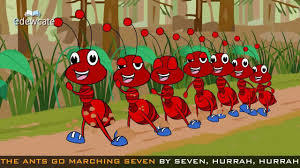The Ants Go Marching
 The ants go marching one by one, hurrah hurrah
The ants go marching one by one, hurrah hurrah
The ants go marching one by one, hurrah hurrah
The ants go marching one by one
They march and one says he is done
The ants go marching, hurrah hurrah
The ants go marching two by two, hurrah hurrah
The ants go marching two by two, hurrah hurrah
The ants go marching two by two
They march and one gets crushed by a shoe
The ants go marching, hurrah hurrah
The ants go marching ten by ten, hurrah hurrah
The ants go marching ten by ten, hurrah hurrah
The ants go marching ten by ten
They march and one gets eaten by a hen
The ants go marching, hurrah hurrah
The ants start walking in one row, lose a member, and then start walking in two rows. This continues, with them losing a member before increasing the number of rows, until they are walking in ten rows. If every time they walk in a new amount of rows, the number of ants per row of the marching contingent is still equal, what is the least number of ants they could have started out with ?
i.e They may have started with 5 ants in one row and then 4 ants in two rows (2 ants per row) and then 3 ants in three rows (1 ant per row) and then it doesn't work anymore (can't evenly split 2 ants between four rows).
The answer is 2519.
This section requires Javascript.
You are seeing this because something didn't load right. We suggest you, (a) try
refreshing the page, (b) enabling javascript if it is disabled on your browser and,
finally, (c)
loading the
non-javascript version of this page
. We're sorry about the hassle.
let the number of ants be x.from the given problem we can say that x-1 is a multiple of 2,x-2 is a multiple of 3,x-3 is a multiple of 4,.and so on upto x-9 is a multiple of 10.the same can be written as x-1=2a , x-2=3b , x-3=4c,............and so on upto x-9=10i....Now add their respective factor for each equality on both sides i.e...,2,3,4,5,6,7,8,9,10. we get x+1=2a+2=2(a+1),,,,,x+1=3b+3=3(b+1)..,x+1=4c+4=4(c+1) and so on upto x+1=10i+10=10(i+1)....from above we can see that x+1 is a multiple of 2,3,4,5,6,7,8,9,10.So we have x+1=LCM of (2,3,4,5,6,7,8,9,10) * k=(2520 k).therefore x=(2520 k)-1...for least value we have k=1.this implies x=(2520*1)-1=2519.............:)